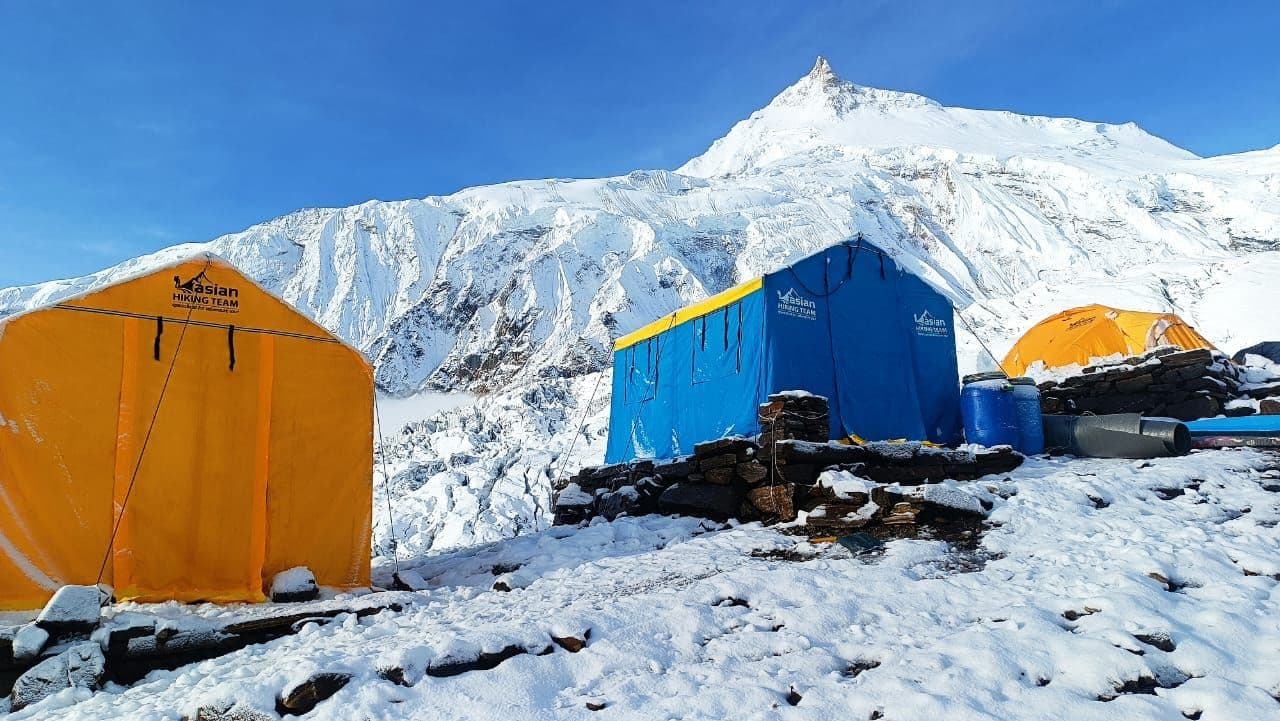
Manaslu peak Expedition
Manaslu, the eighth-highest mountain in the world, stands at 8,163 meters (26,781 feet) above sea level. It is located on the northern side of the Gorkha district, along the Budhi Gandaki Valley. The name “Manaslu” is derived from the Sanskrit word Manasa, meaning “intellect” or “soul.” The total climbing route from the Base Camp spans approximately 12.2 km.
Manaslu, the eighth-highest mountain in the world, stands at 8,163 meters (26,781 feet) above sea level. It is located on the northern side of the Gorkha district, along the Budhi Gandaki Valley. The name “Manaslu” is derived from the Sanskrit word Manasa, meaning “intellect” or “soul.” The total climbing route from the Base Camp spans approximately 12.2 km. The nearest settlement to the Manaslu peak is Samagaun, situated about 1.9 km away.
Manaslu’s summit was first successfully reached on May 9, 1956, by Toshio Imanishi and Gyalzen Norbu, members of a Japanese expedition. Because of this historic ascent, the three main peaks of Manaslu are often associated with Japanese climbers.
The Manaslu Expedition 2025, organized by the Asian Hiking Team, offers climbers a chance to summit this majestic 8,163-meter peak. The expedition is scheduled to begin on September 8, 2025, during the prime autumn climbing season.
The primary trekking route to Manaslu Base
Trip Facts
Group Size
2-15 persons
Maximum Elevation
8,163 meters (26,781 feet)
Location
Manaslu region, Gorkha district
Route
Southern routes (Southwest Face route)
Grade
Mountaineering VII
Best Season
Spring & Autumn (autumn is the best)
Accommodation
Hotel and Camping
Transportation
Drive and trek to base camp.
Summit the majestic Manaslu at 8,163 meters (26,781 feet), the world’s eighth-highest mountain.
Trek through pristine landscapes of the Budhi Gandaki Valley, experiencing remote villages, rich culture, and diverse flora and fauna. Explore traditional Gurung and Tibetan-influenced villages such as Samagaun, where you can immerse yourself in local customs and hospitality.
Follow the established climbing route, widely regarded as the safest and most reliable path to the summit.
Witness spectacular views of snow-capped peaks, glaciers, rhododendron forests, and alpine meadows throughout the trek and climb.
Led by experienced guides and Sherpas from Asian Hiking Team, ensuring safety, logistics, and expert support throughout the journey. Comprehensive expedition support including high-quality gear, fixed ropes, and emergency evacuation plans.
Follow in the footsteps of the first successful Japanese ascent in 1956, embracing the mountain’s rich climbing heritage.
- Pick up/ Drop from International Airport to Hotel.
- Kathmandu to Sotikhola/Machhekhola/Besishar/Dharapani (Trekking starting and ending land transport as itinerary).
- Hotel in Kathmandu with breakfast as itinerary (here are so many options, we provide on cost 4-star hotel if you want higher star please add on option.
- Accommodation during the trekking: Single/Twin-sharing room with wooden beds, foam mattresses, and blankets (bring a sleeping bag for extra warmth/hygiene). Most of the place have shared toilets (usually Asian-style squat or Western toilets). Some of the place has attached toiled. Hot showers available (on extra cost). Higher up, hot water is scarce.
- Base Camp single tent with mattress and pillow for each member, climbing Sherpa, BC staff and Liaison Officer.
- High altitude tents for all members and climbing Sherpa’s.
- All camping equipment like camp furniture (table, chairs), kitchenware, kitchen, dining, guest, shower and toilet tents in Base camp.
- Camping / Upper camps’ meals (Breakfast, Lunch and Dinner) with hot drinks, high foods etc.
- Snacks for climbing: Pack energy bars, nuts, chocolate, or local chyura (beaten rice) for quick energy boosts between meals during the climbing/expedition only.
- Breakfast: Porridge/Oatmeal (often with honey, fruits, or nuts), eggs (fried, scrambled, or omelets with veggies), Pancakes or Tibetan Bread (served with jam, honey, or peanut butter), Muesli/Cornflakes (with hot or cold milk), Tea/Coffee (black, milk tea, or ginger lemon honey tea) etc.
- Lunch: Dal Bhat (Nepali staple: lentil soup, rice, vegetable curry, and pickles—unlimited refills!), Noodles/Pasta (fried noodles, garlic pasta, or ramen), Momos (dumplings stuffed with veggies or meat), sandwiches (egg, cheese, or tuna), soup (garlic, mushroom, or veggie—popular for warmth and hydration) etc.
- Dinner: Dal Bhat, Curries (veggie, potato, or chicken with rice or chapati), Thukpa (local noodle soup), Pizza, Pasta, Fried Rice/Noodles, Desserts (apple pie, rice pudding, or Snickers rolls etc.).
- Manaslu special trekking permit.
- Manaslu Conservation permit /Entrance fees.
- Annapurna Conservation permit / Entrance fees.
- Manaslu Expedition Permit /Royalty.
- Government appointed Liaison Officer: insurance, equipment, transportation, bonus, and daily wages for liaison officer.
- Local Entry permit / Entrance fees.
- Entrance fees in Monastery/temple.
- Expedition Sherpa Guide: A First Aid and Eco trained & Government licensed holder professional equipped English-speaking one high altitude Sherpa guide per member.
- Support Sherpa: we use high altitude Sherpa guide for transport to upper camps.
- Porter/Yak: Baggage/ Equipment allowance for trekking up and down is maximum 50-60kg per person.
- Base Camp Manager, Base Camp cook, necessary staffs.
- Wages, meals, accommodation, equipment, medical and accidental Insurances for Sherpa guide and other staffs.
- Peak /trekking Map /Itinerary: Asian Hiking Team provides free a copy of trekking map /trekking/peak Itinerary to our client.
- Group Climbing equipment such as fix ropes, main ropes Ice tool, Ice screws, Ice Bar, Carabineers, Locking carabineers, Short-5- millimeter accessory cords, Slings etc.
- Emergency Oxygen bottles (3+ bottles per member above 8000m peak and for Everest and Lhotse 5+ bottles) mask and regulator.
- Solar panel/ generator at Base Camp for light and charging small electronics (eg. mobile phones, amateur digital cameras and handheld video cameras).
- Rope fixing fee.
- T-short: Asian Hiking Team provide the company T-short and one special souvenir each member.
- Certificate: Expedition success certificate for your memory and awardees.
- First Aid: First aid is the immediate assistance given to someone who is injured or ill until professional medical help is available. Its goal is to preserve life, prevent further harm, and promote recovery. Asian Hiking Team staff carry the basic first aid. You need to bring your own personal medicine with you.
- Satellite phone carrying by Guide for communication and available for members with nominal cost.
- Farewell dinner: Asian Hiking Team provide a farewell dinner with Nepalese cultural programs the last day of the trip.
- Travel & Rescue arrangement service: You should bring insurance, must include emergency air ambulance/helicopter rescue services.
- International air ticket to/from Nepal.
- Nepal tourist visa: for the Nepal Tourist visa fees, process of visa, further rules and regulation please check here https://www.immigration.gov.np.
- Accommodation: Asian Hiking Team provide the hotel in Kathmandu and during the trekking as itinerary. If you stay an additional day, you need to pay an extra cost.
- Meals: Lunch and Dinner are not includes in Kathmandu.
- Hot drinks: Tea/ Coffees/ Hot water, hot showers etc during the hotel/lodge.
- Cold/soft drinks: All cold drinks, alcohol drinks, beer, bottle water etc.
- Snacks: Pack energy bars, nuts, chocolate, or local chyura (beaten rice) for quick energy boosts between meals during the trekking.
- Personal trekking/climbing gears & clothing (some of the equipment is possible to rent in Kathmandu): please check in check list for peak climbing equipment list…
- Personal solar pack (if any) for charging heavy electronics (laptops, professional camera, batteries, etc.).
- Internet / Wi-Fi/Telephone: There are almost all trekking reason you can buy internet/ Wi-Fi service in the hotel/base camp. It is also possible to buy the NCAL or NTC Sim card for telephone or use data.
- Kathmandu: During the sightseeing in Kathmandu or Pokhara the entry fees for Temple or Monastery, Durbar Square are not includes on the cost.
- The tip for guide or porter/ Summit bonus: It's a way to show appreciation for good service and is often left as a small present or in addition. Tips are a common practice in many cultures and are often expected for services.
- Porter/Yak: Asian Hiking Team provide 50-60kg. If you have more weight hire the additional porter, the cost in not includes.
- Sherpa/ Guide: If you want personal Sherpa/guide, it is not including on the cost.
Tailored add-ons in Nepal trips refer to customizable essentials that enhance and personalize your travel experience, allowing you to align your journey with specific interests, preferences, and schedules. These add-ons can be combined into various types of trips, including trekking, expedition, climbing, cultural tours, wildlife safaris, and adventure activities.
Customized Accommodations: Choose from a range of lodging options, from luxury hotels to homestays, to match your comfort and budget preferences. Upgrade your stay to accommodation featuring attached bathrooms during your trek. Enjoy additional comfort at select stops.
Helicopter/mountain flight: if you have short time frame, we recommended you that one hour Mountain flight or helicopter flight to visit Everest base camp or Annapurna base camp or Langtang (Kyanjin Gomaba) or Gosaikunda, Muktinath. The cost depends on number of members, destination etc.
Adventure Activities: Incorporate thrilling experiences such as paragliding in Pokhara, bungee jumping over the Bhote Koshi River, zip-lining, mountain biking, or...
Asian Hiking Team’s Guides/Sherpa are professionals with proven records of honesty and personal integrity, committed to environmentally responsible climbing practices that minimize ecological impact. Our Climbing Guides possess extensive knowledge of all climbing disciplines, local cultures, customs, and religions, and they enthusiastically share these insights with clients. All Guides are fluent in English and speak additional languages upon request.
Asian Hiking Team’s Climbing Guides/Sherpas bring years of experience and exceptional expertise in all facets of Nepal mountaineering. Each holds a Nepal Government License, Mountaineering Association Accreditation, and Summit Certificates for Nepal Himalayan peaks. Our high-altitude Sherpa guides are qualified through rigorous training from NMA, TAAN, and NATHAM.
Every climbing guide undergoes comprehensive technical training and possesses practical mastery of:
- Rock, ice, and snow climbing techniques;
- High-altitude camp logistics, setup, and operations;
- Advanced safety protocols for high-altitude camping;
- Fixed-rope climbing, belay techniques, and all mountaineering gear usage;
- Oxygen systems, high-altitude nutrition, and avalanche/mountain...
The difficulty of the climbing or expedition depends on the peak. Trekking peaks are easier than high mountain expeditions, but some of the less high trekking peaks are also technical for climbing. We have to calculate the grade focus on following topic:
a) Length of trek and walking days /Easy glacier route. b) Which Mountain and altitude conditions. c) Average altitude, maximum altitude and average gain/loss per day. d) Likely prevailing weather conditions and temperature range. e) Remoteness of local services and general level of comfort. f) Rock climbing or Ice climbing. g) Technical climbing and complicated glaciers. h) Steep climbing or long snow/ice slopes i) Very difficult Long, serious, remote, and highly technical Climbing over thousands of vertical feet j) High commitment, and few bivouac sites.
Grade I: Easy glacier rout, average altitude. Grade II: Half a day or less for the technical portion of the route or not technical but exposed to knife-edged ridges, weather, and altitude. Grade III: Moderate to...
Hotel/ Lodge: Single/Twin-sharing room with wooden beds, foam mattresses, and blankets (bring a sleeping bag for extra warmth/hygiene). Most of the place have shared toilets (usually Asian-style squat or Western toilets). Some of the place has attached toiled. Hot showers available (on extra cost). Higher up, hot water is scarce.
Tented Camping: Tented camping is a classic and essential part of trekking, peak climbing, and expedition in remote areas of the Himalayas where teahouse accommodation is unavailable. Asian Hiking Team provides Tent (2-person or single occupancy Dom and Box tent depends on area and numbers of days), Sleeping mat (foam or inflatable), Dining tent, kitchen tent, toilet tent (group use - for expedition), Kitchen equipment and utensils (carried by support crew), Power bank or solar charger, heater, Generator (for expedition) etc.
Meals: During the hotel/Guest house trekking, there are international menu so you can choose whatever you like. During the camping, our cook...
Transport in Manaslu Expedition
Here’s a traveling from Kathmandu to Sotikhola to Machhe Khola to popular trailhead options for the Manaslu Circuit trek/Expedition:
Kathmandu to Machhekhola/Sotikhola appro. 160KM
Public Bus (Kathmandu to Machhe Khola via Sotikhola – Appro 160KM)
Departure point: New Bus Park (Machhapokhari/Gongabu), around 6–8 AM
Route: Kathmandu to Dhading Besi to Arughat to Sotikhola to MachheKhola
Travel time: 9–12 hours
Note: Buses are local; expect stops, crowding, rough/unpaved roads past Sotikhola. May you need to change the bus in Aarkhet bazar or Sotikhola.
Private Jeep / 4WD
Capacity: 6–7 passengers; great if in a group
Travel time: To Sotikhola: 4–7 hours and Full journey to MachheKhola: 6–8 hours
Advantage: Comfortable, flexible departures, breaks for meals/photos, better handling of rough roads.
Dharapani to Besisahar 35KM
Local (Shared) Jeep
Departure: Leaves frequently (usually every hour once full) directly from Dharapani
Route: 35 km along the newly paved Army-built mountain road
Travel Time: About 5–6 hours
Private Jeep
Capacity: Seats 5–7 passengers
Travel Time: Faster—around 4–5...
General Climate Overview Nepal's climate is incredibly diverse due to its dramatic range in altitude—from the lowland Terai plains (around 60 meters above sea level) to the Himalayan peaks above 8,000 meters. The country experiences five main seasons: spring, summer, monsoon, autumn, and winter. Each region and elevation zone has its own unique weather patterns.
Terai Region (Southern Plains) Climate: Subtropical Summer (May–June): Hot and humid, temperatures often exceed 37°C Winter (Dec–Feb): Mild, temperatures range between 7°C to 23°C Receives significant rainfall during the monsoon (June–September)
Hilly Region (Mid-Hills & Valleys) Climate: Mild and temperate Cities like Kathmandu and Pokhara experience: Summer: 19°C – 35°C Winter: 2°C – 12°C Pleasant weather year-round with occasional winter chills and summer showers
Mountain Region (High Himalayas) Climate: Alpine to Arctic Summer: Cool to cold, depending on altitude Winter: Severe cold with frequent snowfall Temperatures can drop below -20°C at high passes and base camps Monsoon rains are lighter, but weather remains unpredictable
Nepal experiences four distinct seasons, each offering different trekking experiences:
Autumn...
Manaslu Expedition Royalty is in spring season 1500, Autumn seasons 3000, Winter/summer season 1500.
Royalty for Foreign Climber per Person in US Dollar
(Effected from 1st September 2025):
- Everest Normal Route - Spring Season 15,000, Autumn Season 7500 and Winter/Summer 3750
- Everest Other Route - Spring Season 10,000, Autumn Season 5000, Winter/Summer 2500
Others Mountain more than 8000 - Spring Season 3000, Autumn Season 1500, Winter/Summer 2500
- Mt. Manaslu - Spring season 1500, Autumn seasons 3000, Winter/summer season 1500
- Mountains - 7501 m. - 7999 m. Spring Season 1000, Autumn Season 500, Winter/Summer 250
- Mountains - 7001 m. - 7500 m. Spring Season 800, Autumn Season 400, Winter/Summer 200
- Mountains - 6501 m. - 6999 m. Spring Season 500, Autumn Season 250, Winter/Summer 200
Mt. Amadablam (6812 m) - Spring Season 1000, Autumn Season 1000, Winter/Summer 500
- Mountains - Less than 6500 m. Spring Season 350, Autumn Season 175, Winter/Summer 175
Note: The...
Altitude Mountain Sickness (AMS) Trekking in the Himalayas poses risks of Altitude Sickness (AMS). The body needs time to acclimatize to higher altitudes, a process known as acclimatization.
Types of Altitude Illnesses (Acute Mountain Sickness AMS)
- High Altitude Pulmonary Edema (HAPE): Fluid in the lungs
- High Altitude Cerebral Edema (HACE): Swelling of the brain
- High Altitude Retinal Hemorrhage (HARH): Bleeding in the retina
Common Symptoms:
- Headache
- Nausea, loss of appetite
- Sleep disturbance
- Dizziness, mild weakness
- Swelling of hands and face
Severe Symptoms (Seek Immediate Descent):
- Severe, persistent headache
- Shortness of breath at rest
- Confusion, loss of coordination
- Bluish lips or face
- Coughing blood-tinged sputum
- Coma or unconsciousness
Prevention Tips:
- Drink 4–5 liters of fluids daily (avoid alcohol)
- Ascend slowly and rest if symptoms appear
- Avoid sleeping at a higher altitude if symptoms persist
- Take Diamox (consult your doctor) before flying to altitude
Food & Water Safety In Nepal, water and food contamination are common causes of illness.
Do: *...
NTC/Ncell SIM cards work in most areas along the Manaslu trekking route; however, network coverage is unavailable during the higher passes or in the gorge section. NTC network is the best in Manaslu area. In case of emergencies, a satellite phone is used for communication.
Landline and mobile phone services are available in Nepal. The network covers Kathmandu, major cities and towns and most of Nepal, except some rural Himalayan places. The Nepal Telecommunications Corporation is the national service supplier. There are also private service suppliers such as Hotels and private communication centres also provide long distance telephone, internet and fax facilities. You can get SIM card either NTC or N Cell with data to use the internet. The price for SIM card US$ 1, and you need to recharge as you require. You can buy a SIM card inside the airport or anywhere in Kathmandu or major cities. You need...
Asian Hiking Team strongly recommend that you take out trip cancellation, air ambulance/helicopter rescue insurance. You should be aware that some policies do not include, or restrict, cover for this type of travel. You must ensure that the policy you do take provides an adequate level of protection and covers you for the activities involved.
You must carry proof of insurance (e.g. your insurance certificate) with you on the holiday; if you cannot provide this at the start of the holiday, you will be required to take out a suitable policy at that time. If this is not done or impossible for practical reasons, then you will not be allowed to continue with our trekking/climbing trips and will not be entitled to any refund for services not provided. Your insurance must include emergency air ambulance/helicopter rescue services.
Recommended Insurance Company in Nepal (Only for Nepali) Neco Insurance Co Ltd. - www.necoinsurance.com.np Sagarmatha Insurance Ltd....
At Asian Hiking Team, we believe that every journey should be both transformative for the traveler and respectful to the host environment and communities. Responsible tourism isn’t just a practice—it’s a core value that shapes how we operate, lead tours, and engage with people and places.
Environmental Responsibility We are committed to minimizing the environmental impact of our operations while encouraging a greener way of traveling.
Our eco-conscious practices include:
- Limiting group sizes to a maximum of 20 to reduce environmental pressure.
- Using stainless steel mugs for tea/coffee to reduce single-use waste.
- Relying on gas for cooking instead of wood fires, preserving forests.
- Carrying out waste from high altitudes for proper city disposal.
- Avoiding the use of soap near natural water sources.
- Using reusable containers and encouraging travelers to bring their own refillable water bottles.
- Leaving campsites cleaner than we found them.
- Encouraging minimal water usage, especially in high-altitude regions.
- Preventing trail damage...
Ice Axe/Ice Hammer : Bring a lightweight axe with a pick that will stick easily in hard glacier ice. Attach a light weight wrist leash that is usable for climbing steeper terrain.
Crampons : These must be sharp and must fit your boot perfectly.
Harness : Make sure the buckle is easy for you to thread in cold conditions! Gear loops will be useful for this trip as well as adjustable leg loops.
Helmet : Be sure you can comfortably fit a warm hat underneath.
Hardware : Bring 3 locking and 4 lightweight regular carabineers. It is helpful if at least one of the locking carabineers has a "key gate", like the Petzl Attaché. Bring one handled ascender and one Petzl Tibloc for ascending the fixed rope. You will need rigging material--two sewn 48" nylon slings and 10' of 8 mm perlon should be sufficient. Also include one small 5 mm prussik loop (about 4 feet of cord tied with a double fisherman's knot) for a rappel backup. For rappelling the Black Diamond ATC Guide is good since it can handle ropes from 7.7mm to 11mm. A Figure 8 is an old standby and works on a variety of ropes and also icy ropes. While it twists the ropes more, it is quite foolproof. You might consider both, in case you drop one of them and lose it. Our guide have Ice tools, Ice screws, Carabineers, Locking carabineers, Short-5- millimeter accessory cords, slings.
Insulated Parka/Expedition Suit : Heavyweight insulated expedition Suit/parka with hood.
Jacket : Lightweight waterproof-breathable construction with a hood.
Pants : Lightweight waterproof-breathable shell pants or bibs with full-length leg zippers. ALSO, very useful are synthetic insulation full-zip pants, for example, Mountain Hardware Compressor Pants--for evenings and cold summit days.
Mid-Layers : Fleece or Soft Shell layering pieces that work well with the rest of your clothing. A Soft Shell jacket and an expedition weight long john top will work well.
Climbing Pants : Look for construction that provides freedom of movement and/or stretch materials. Fabric should be a breathable synthetic that preferably holds up to abrasion.
Base Layers : - 2 synthetic tops and 1 bottom. Zip neck tops are the way to go.
Mittens : Fleece mittens with an over mitten. Nothing competes with a mitten for warmth when the going got tough.
Ski Gloves : A warm insulated glove with leather palm will be worn a lot of the time.
Light Gloves : Polypropylene or fleece. Leather palms handle the fixed line better, Leather gloves or good abrasion resistant climbing glove for the rock sections.
Stocking Hat : Wool or fleece stocking hat with ear protection, Neck Gaiter and/or a Buff (highly recommended), Baseball hat and Bandana.
Trekking Poles : Poles come in handy for balance and easing impact to your knees. Get collapsible poles that can attach to your backpack and fit into your Duffel.
Backpack : You may choose to bring a smaller "day pack" for your airline travel carry on, and this can be used on the trek if you want to carry a smaller (35 liter or so), light trekking pack. You need a pack big enough for your clothes, water, camera, food, etc. during the day.
Pack Cover : Waterproof rain cover for your trekking pack.
Trekking Clothes : Light hiking pants and / or hiking shorts for warm weather down low-NOT cotton. Shirts for hiking on nice days (t-shirts OK, quick-drying synthetic fabric is better.) Don't overdo your trekking clothes. A pair of shorts, long pants and a couple of shirts will do. Some pair of Socks, Underpants/panties/Bra, Belt, Skirt, one set sport sandals and Trousers, you can handwash them during the trek as needed.
Lightweight Approach Boots : Find a pair that fits and log some miles in them before your trip. A low cut shoe is adequate, but some hikers will prefer more ankle support.
Sleeping Bag : Bring a sleeping bag comfortable to -20 for trekking, however it is better to bring -30 for climbing. During the trekking in hotel/guest house -20 is fine but on the tented home you need -30. Down is lighter and much more compressible. Keep in mind that many of your nights will be much warmer than -20, especially on the trek in to base camp.
Double Climbing Boots with expedition liners : Make sure your crampons can be adjusted to fit them (La sportiva - Olympus Mons Cube).
Approach boots : Which will work on the trek and approach to Camp 1, and even up to Camp 2 if conditions warrant.
Gaiters and Yaktrax or Kahtoola Micro spikes : in case of snow.
Socks : Four/five sets of climbing socks.
Eyewear : Bring good sunglasses with side protection. For contact lens wearers, ski goggles with light color lenses (for use at night) might be useful in windy conditions. The ski goggles are essential for all climbers in really stormy conditions and can serve as an emergency backup for broken or lost sunglasses.
Vision correction : Bring extra prescription eyeglasses or contact lenses if you wear them. Lens solutions are not widely available in Nepal, bring enough for the duration.
Wrist Watch : With alarm and night light. An altimeter watch is useful.
First Aid : Hand sanitizer (Purell), moleskin or Compede, athletic tape, aspirin (some climbers take a baby aspirin every day up high) and/or ibuprofen / acetaminophen, Imodium, Band-Aids, antacid, insect repellant, ear plugs, and two rolls of toilet paper in quart Ziploc bags (we will have a supply at Base Camp), small towel, soap/shampoo.
Prescription Medications : Antibiotic for upper respiratory problems, Antibiotic for GI problems, Diamox for acclimatization (125 mg tabs recommended; enough for a week or more), Tylenol 3 or similar for severe headaches, Asthma medication, if any history.
Skin Care : Sun block lotion (at least #30 protection factor -- have at least one smaller tube (1 oz) that can fit in your pocket) and lip salve. Put your lip protection on a string and hang it from your neck. That way, you'll use it. It also works great for your nose.
Garbage Bags : 2 or 3 large plastic bags make great liners for your pack in wet weather.
Personal Snack Food : The food is great on the trek, but you might enjoy a few snacks (not more than 5 pounds) from home and also some drink mixes if you like these to add to your water bottle (let the iodine have 30 minutes contact time before adding). Summit climbers should bring some high altitude snacks they prefer for hard days.
MP3 Player and Books : As you want to read on the way to trekking. Plan on sharing books on hotel/guest house and on sharing books with the Base Camp.
Pee Bottle :
Chemical Hand Warmers :
Headlamp : Bring a good LED headlamp with 2 sets of lithium batteries for cold conditions.
Water Bottles : 2 wide mouth plastic water bottles with insulated covers. A small Thermos bottle is great for cold mornings. Bring a pee bottle too.
Water purification : Iodine tablets (Potable Aqua or similar) or iodine crystals (Polar Pure). One bottle of Potable Aqua (enough to treat 25 liters) should be more than sufficient.
Utensils : Bring an insulated mug with a lid, a decent sized bowl, spoon, pocket knife and lighter.
Backpack: Climbing Backpack : Medium size internal frame pack (60 liter capacity). Look for a pack which is comfortable to carry, very durable, as light as is reasonable and one which has a minimum number of bells and whistles.
Sleeping Bag : Bring a sleeping bag comfortable to -35 for expedition. Down is lighter and much more compressible. Be sure to bring a compression stuff sack. Keep in mind that many of your nights will be much warmer than -20, especially on the trek in to base camp.
Duffel Bags : We normally pack all our equipment in two large Duffel bags. Make sure they are well labeled with indelible ink as well as a travel tag. The duffels go on the trek/climb with you and will be carried by porters and yaks. Except for them to get wet and muddy, so rugged, waterproof duffels are good. Bags with wheels are nice for the airport, but the porters and yaks don't like to carry them, so don't bring wheeled bags (or at least not two of them). You will also store some travel clothes at the hotel in Kathmandu while trekking, so a small additional bag with a lock might be handy. Bring 5 large plastic garbage bags to pack gear inside duffels to protect gear from rain.
Travel Wallet : Some type of secure travel wallet is a must. Remember a pen for travel documents.
Passport (valid for at least 6 months) : It is easy to get your Nepal visa on arrival in Kathmandu at the airport bring a passport photo. Bring a copy of the information pages and a couple of extra passport photographs. Carry these in a separate location. You'll be glad you did if you ever lose a passport.
Camera : with spare batteries, and film or memory cards, but keep it reasonable and weight. Consider a small USB drive to make it easy to share photos with your teammates.
Bathing Suit : Towel, Toothpaste and brush, floss, mini hairbrush, razor, soap, mini bottle of shampoo, travel mirror, nail clippers, Pie bottle etc.
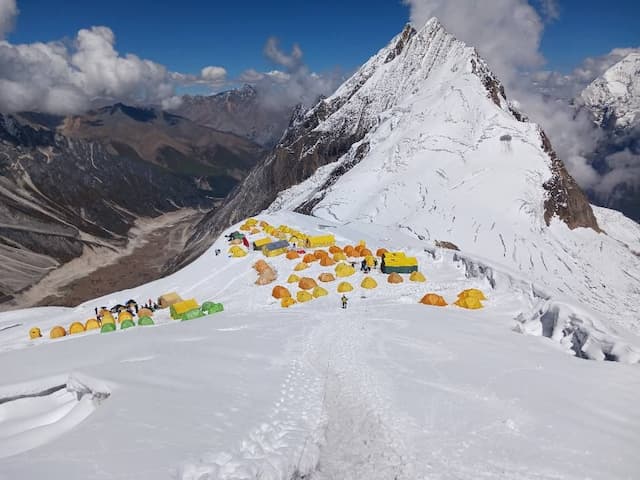
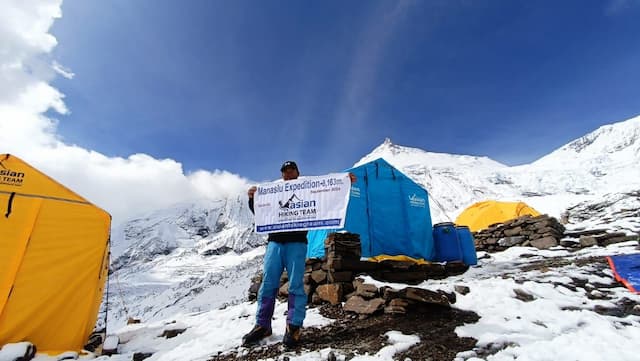
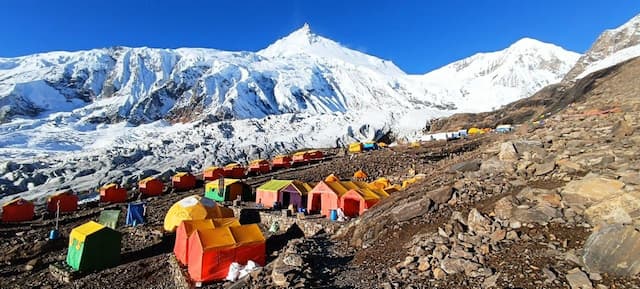
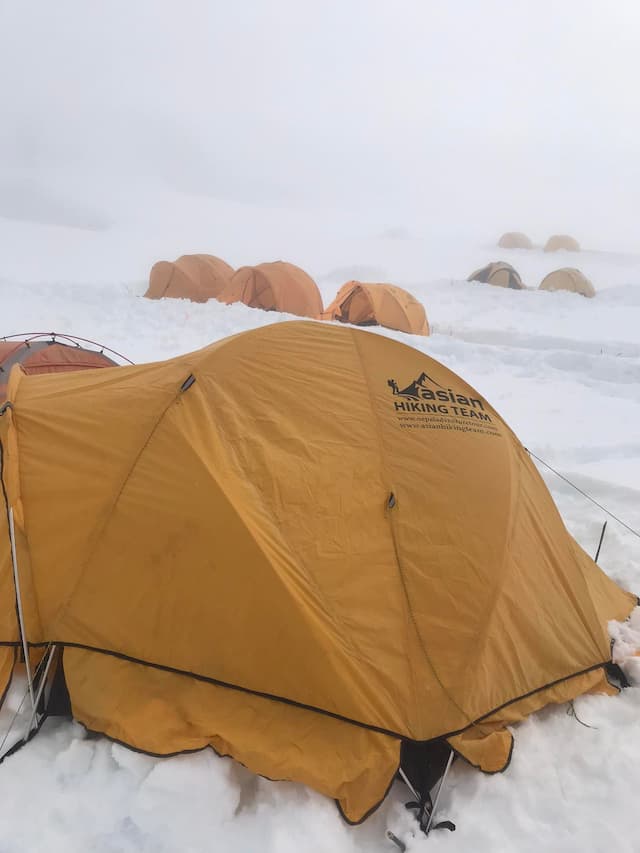
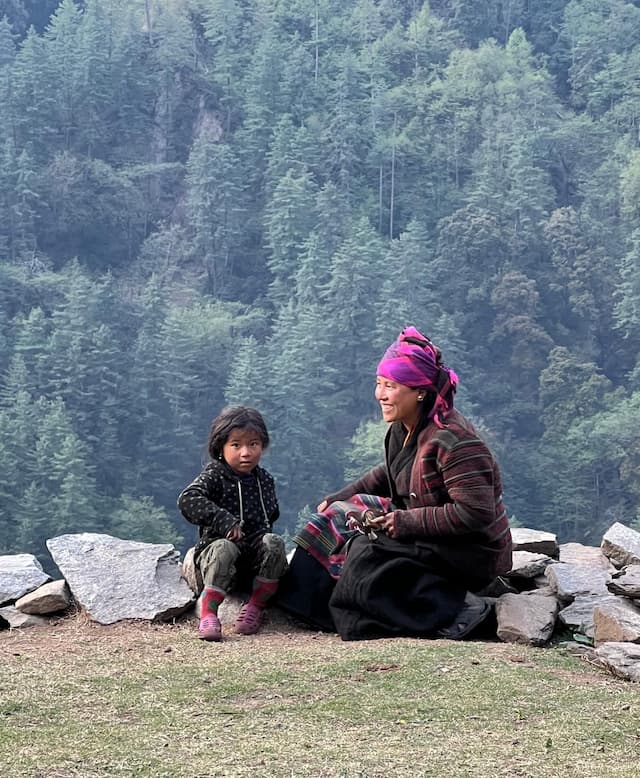







 0
0

 0
0 0
0 0
0 0
0